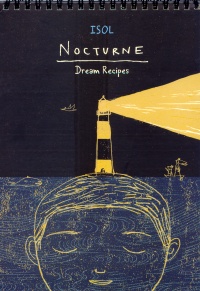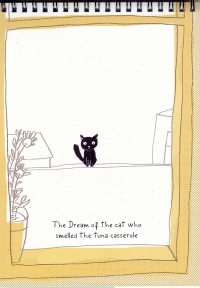| ________________
CM . . .
. Volume XIX Number 6 . . . . October 12, 2012
excerpt:
Nocturne offers readers 11 glow-in-the-dark, ‘five-minute dream recipes’ to inspire and guide one’s dreams every night before going to bed. Just place a page under a strong light for 5 minutes and turn off the light, and the page will reveal a variety of engaging glow-in-the-dark ‘dream drawings’ that will inspire, laugh, confuse and “guide your sleeping hours”. Viewed in daylight, each of Nocturne’s 6.5 x 9 inch pictures is composed of three coloured and two-toned (black and white) line-drawn ‘snap-shot’ images taken from daily life. On one page, a child has fallen asleep reading a book under a tree, on another two early fall rabbits have just poked their heads out of their borrows, and in a third image, a singer is lying peacefully in a casket. Once the reader’s imaginative and predictive mindset is set in motion by these daylight images, turning off the lights reveals luminescent line-drawings superimposed upon the originals that stimulate even more explanations, predictions, and imaginative story. For example, the ‘lights-on’ image of the two rabbits poking their heads out of their burrows is transformed to reveal a winter scene of the same two rabbit snoozing deep in their underground burrows with their 10 kits chasing each other through the maze of tunnels. Additionally, when the lights are turned off after viewing ‘The Dream underwater’, the diver is revealed plunging into a magical world below the water surface where a mermaid with long flowing hair swims by, making one wonder what further surprises lie deep in this luminescent ‘dream’. Instructions on the back of the book, and on the first few pages inside the book, are clear and simple to follow, and explain how to activate the luminescent ‘dreams’. However, it wasn’t until I had read the book twice that I realized that the book also has a fold out base. When unfolded, this base is engineered to work with the sturdy front and back hard covers to form a triangle that allows readers to stand the book up on its own and flip through the pages (not unlike a roll-a-dex…for those old enough to remember such things). This ‘hands-free’ stand can be used to charge up the glow-in-the-dark ink and/or to stand the book up on a bedside table for viewing as one drifts off to sleep. Although Nocturne is another brilliant example of the highly imaginative and engaging nature of Isol’s work in children’s literature (and is another strong example of why her work has been nominated twice for the international Hans Christian Anderson Award for children’s literature), the engaging nature of this book is also reason for passing along a caveat. That is, the images in this book may stimulate overactive imaginations and could result in dreams that some children may find uncomfortable or even frightening enough to keep them awake at night. For example, in ‘The roommate Dream’, a four-fingered black animal or monster is shown crawling out of a small door in a room where a girl lies asleep in her bed. When the lights are turned off, the glow-in-the dark ink reveals a large (five times the size of the girl) smiling, disheveled and furry ‘wombat-like’ creature sporting a long forked tail and snuggling on top of the girl and hugging her. Additionally the ‘Dream of the dead singer’ shows a smiling singer in a casket surrounded by two bereaved friends, which, when plunged into darkness, reveals these three as skeletons creating music together. In short, the evocative nature of some of these drawings may overstimulate some young children’s imaginations and may result in some difficulties in their getting to and staying asleep. Nocturne also comes with one page titled ‘The drawn dream’. On this page, the publisher has covered the entire page with glow in the dark ink. Readers are then encouraged to take a dark crayon (a dark coloured pencil crayon worked for me) and draw in their own dream. Although not applicable for situations where large numbers of children will be circulating and reading the book (e.g., schools), it is an excellent tool for an individual child to draw her/his own dream. This page can also be used for children and their caregivers to explore and begin to understand unsettling dreams (including those associated with the unsettling dreams in this book). Isol’s Nocturne stimulates and tickles the reader’s imagination and will engage both young and old readers. My 10-year-old and I could hardly wait to turn off the light and reveal the very imaginative images that were often both surprising and very engaging. We both chuckled when the tiny cat ‘who smelled tuna casserole’ was revealed to be filling the whole page trying to get through the house’s window to the tuna casserole that lay beyond. However, adults should also be aware that some children (especially those with overactive imaginations and histories of struggling to get to sleep) may find some images disconcerting and unsettling. Recommended. Keith McPherson has been an elementary teacher and teacher-librarian in BC since 1984, and he is currently a lecturer for the Department of Language and Literacy Education at the University of British Columbia in Vancouver, BC.
To comment on this
title or this review, send mail to cm@umanitoba.ca.
Copyright © the Manitoba Library Association. Reproduction for personal
use is permitted only if this copyright notice is maintained. Any
other reproduction is prohibited without permission.
NEXT REVIEW |
TABLE OF CONTENTS FOR THIS ISSUE
- October 12, 2012.
AUTHORS
| TITLES | MEDIA REVIEWS
| PROFILES
| BACK ISSUES
| SEARCH | CMARCHIVE
| HOME |

 Although each of these ‘lights-on’ pictures can stands on its own (and naturally inspires predictions of what may have happened before or after each picture), each of these images is also titled to further stimulate the reader’s imagination. For example, the page titled ‘The Dream of growing’ shows a child watering seeds and encourages viewers to predict what will happen to the seeds. ‘The Dream of the cat who smelled the tuna casserole’ is an image of a cat sitting on a fence looking longingly into a house’s window, an image that inspires readers to imagine what the cat will do to get the casserole. And the ‘The Dream underwater’ is a drawing of a diver plunging into a deep body of water that engages the reader’s wonder into what lies below the water’s surface.
Although each of these ‘lights-on’ pictures can stands on its own (and naturally inspires predictions of what may have happened before or after each picture), each of these images is also titled to further stimulate the reader’s imagination. For example, the page titled ‘The Dream of growing’ shows a child watering seeds and encourages viewers to predict what will happen to the seeds. ‘The Dream of the cat who smelled the tuna casserole’ is an image of a cat sitting on a fence looking longingly into a house’s window, an image that inspires readers to imagine what the cat will do to get the casserole. And the ‘The Dream underwater’ is a drawing of a diver plunging into a deep body of water that engages the reader’s wonder into what lies below the water’s surface.